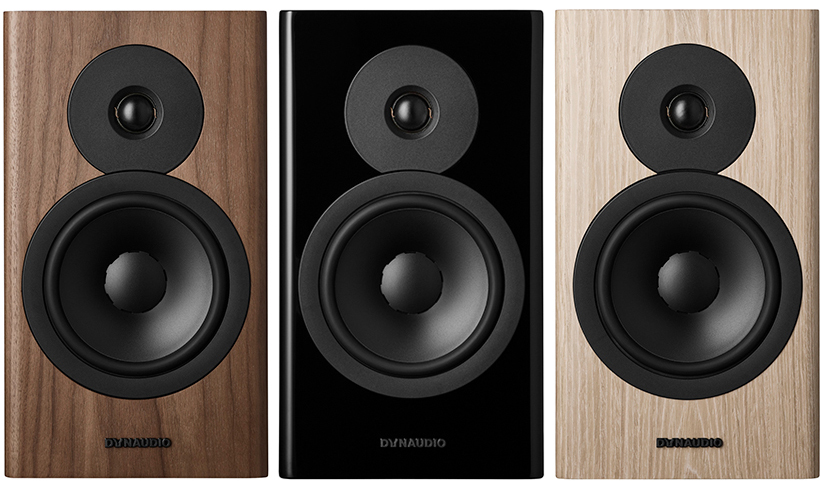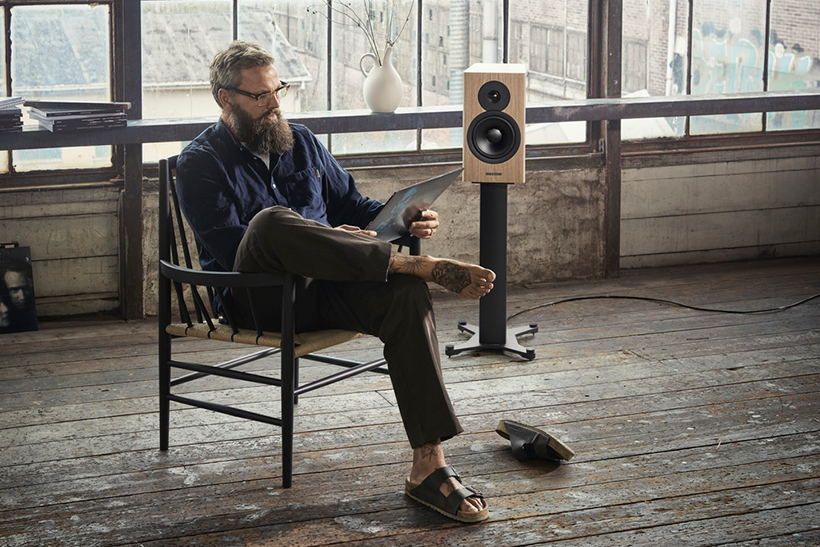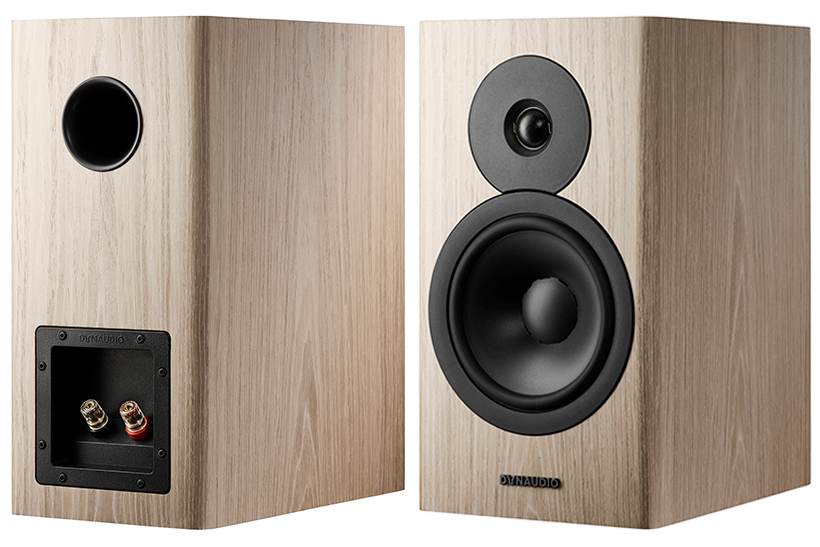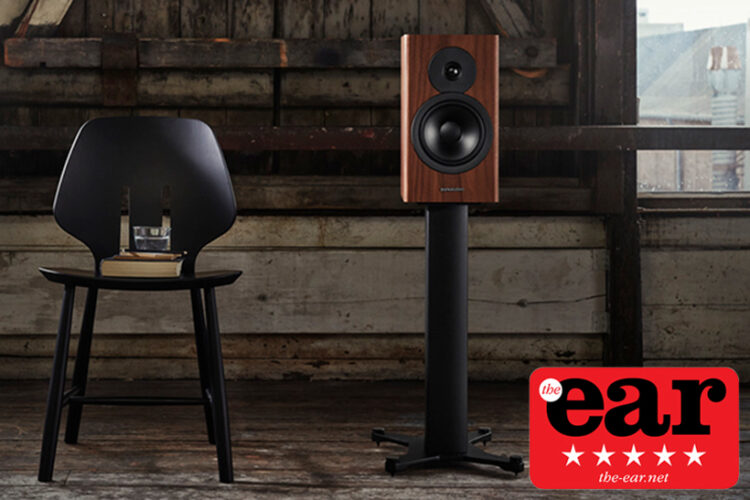Once a loudspeaker company gets to a certain size it can start to use the tech developed for its most advanced designs in the more affordable ranges at the opposite end of the scale. It’s not exactly an economy of scale more an economy of research, it takes time and money to come up with useful improvements but relatively little to scale them down. This is the case with Dynaudio’s Evoke range, it’s not the least expensive in Dynaudio’s extensive catalogue but it is a lot more affordable that the Confidence and Special Forty models which inform its engineering.
There are two Evoke standmounts of which the 20 is the larger with a 180mm main driver in a 38cm (15 inch) high cabinet that is very nicely finished in wood veneer or high gloss paint finishes. It takes its mid/bass driver from the Special Forty anniversary model which has a mesh rather than solid spider suspension – which is the flat donut shaped connection between the middle of the cone and the chassis that’s hidden behind the cone. The tweeter incorporates a Hexis dome, a solid structure beneath the soft dome, which improves airflow behind the driver and is claimed to smooth the response. The main Esotec+ driver is made of magnesium silicate polymer which is moulded in one piece with the dust cap in place, which increases rigidity and gives a stronger connection for the voice coil.

Both drivers have ferrite magnets in an age where many tweeters at least use neodymium, which is more powerful and requires less material but is not necessarily superior in sonic terms. The crossover point doesn’t get much of a mention in the info but signal is transferred from woofer to tweeter at a 3.2kHz, the system as a whole offers 86dB sensitivity for a six Ohm load, which is less efficient than usual for a reflex design of this size. Sacrificing a bit of sensitivity in exchange for linearity in an age of generally powerful amplifiers is no sin however.
Sound quality
Perched on 60cm stands and placed well out from the walls, about 50cm, you get a good bass kick out of the Evokes when they are being driven by a Naim Supernait 2 at least. In fact the low end grunt they produce is positively surprising, small speakers have a psychological advantage in this respect, you don’t expect decent bass extension so when it appears it doubles the fun, and that’s certainly the case here. These Dynaudios are also very good at getting out of the way and letting the sound expand into the room, image scale is very good indeed and it’s easy to close your eyes and forget that there are any speakers at all. The post formed corners of what are good solid cabinets really helps here. They cope with Rhiannon Giddens’ high, powerful voice well and pick out the creaking of the stool on Schiff’s Schubert Sonatas and Impromptus, more important is the way that his metronomic timing is so clearly defined, it’s a fabulous bit of playing and the Evokes let you know all about it. This amp speaker pairing produced audiophile spaciousness with Naim timing and an ease that’s very appealing, it’s what we in the trade call a ‘cracking combo’. Just play Radiohead’s ‘Desert Island Disk’ through it and you’ll get the picture.

Facial hair, tattoos and sandals are not prerequisites for enjoying this speaker
The bass is a bit more fruity than with PMC Twenty.22s but this suits amps like the Cyrus DAC 82 down to a tee. With this amp the PMCs produce s a bigger picture and a tighter groove but the relatively dry nature of the bass is less appealing, this amp is clearly a better match to the Dynaudios. With the Cyrus you get strong physical presence, a real sense of musical tension and solid rather than expansive lows thanks to a lot of detail. The tighter bottom end also allows them to be placed a bit closer to the wall with most material, the bass can sound a bit obvious like this but provides a weight and drive that is rather appealing. On Leifur James’s ‘Red Sea’ (A Louder Silence) you get huge scale and bright, open highs that emphasise cymbals. This Cyrus amp is still on the bright side but the Evoke 20 balances it well and will play at pretty high levels without losing composure. The acoustic guitar picking of Gwenifer Raymond is good and pacey with well defined notes thanks to clear separation. All of which combines to deliver the energy of her playing which gets properly intense with the level wound up.
With a burly ATC P2 power amp in control things get a bit more revealing, the speakers take no prisoners with Burt Jansch’s second album It Don’t Bother Me, which is not the sweetest of recordings, yet the forgiving presentation of the Evoke 20s lets you know this without emphasizing the hardness of the sound from the CD version. The vinyl would probably be a little easier on the ear. The reverb on Cosmo Sheldrake’s marvelous ‘Birthday Suit’ (The Much Much How How and I) is opened up to give depth to this tight and jaunty tune, the richness of instrumentation made clear by the speaker’s transparency. The midrange seems slightly smoothed sometimes and one wonders whether this is an effort to make compressed media such as MP3 sound better or the result of a reduction in distortion in this critical area, I’m inclined toward the latter theory given the efforts that Dynaudio goes to in order to keep all forms of distortion at bay. ‘Close to the Edge’ (Yes) the track has plenty of attack, especially the organ which sounds fabulous even at low playback levels despite limited bass power on the vinyl version. The sheer brilliance of the playing and intensity of the composition make it very engaging indeed when you have speakers of this calibre.

At this juncture I put together a system that seemed appropriate to the Evokes in terms of price at least, using the Cyrus DAC 82 as a streamer and amplifier connected by sensibly priced cabling in the form of Naim NAC A5. This proved to have a rather too forward balance for my tastes but angling the speakers away outwards so that they were almost parallel to one another helped a lot. This still delivered lots of detail, masses of space and thus generous helpings of reverb with decent bass extension and power. I suspect that there are better suited amplifiers however, from Rega and Naim among others, and given the choice I would go for a slightly more relaxed speaker cable such as Kimber 4TC.
The Dynaudio Evoke 20 is a highly capable and revealing loudspeaker that let’s you know exactly what’s going on in the music but does so in a warm, relaxed fashion, this doesn’t stop music that’s frantic or intense sounding the way it was intended but it means that less refined recordings don’t sound harsh or edgy. The eventual result depends on the rest of the system of course, the Dynaudio reflects this very clearly, but with a neutrally balanced source and amplifier you are going to have a lot of fun with this speaker. It’s one of those designs that reminds you just how good standmounts can be, I doubt there’s a floorstander that’s as even handed, revealing and downright entertaining at the price.


